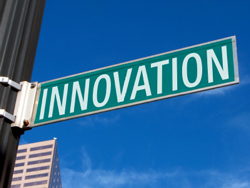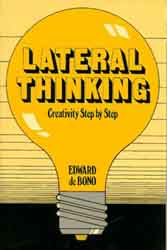Browse by Tag
- "Real" Innovation (2)
- Alignment (6)
- Business Innovation (9)
- Business Plan (2)
- Business Plans (1)
- Creativity (24)
- Critical Success Factors (4)
- Entrepreneurship (9)
- Global Competiveness (4)
- Human Side (11)
- India (1)
- Innovation (4)
- Innovation Consulting (18)
- Innovation Killers (3)
- Innovation Management (18)
- Innovation Tools (17)
- Innovation Training (24)
- Innovations (7)
- Inventions (16)
- IT Innovation (1)
- Leaders (5)
- Leadership (20)
- Leadership Development (13)
- Organizational Leadership (2)
- Organizational Strategy (20)
- Personal Values (6)
- Prediction (5)
- Strategic Innovation (38)
- strategic planning process (4)
- Strategy (3)
- Training (1)
- Vision (5)
- Weekly Dose (8)
Posts by Month
- 2014
- 2013
- 2012
- 2011
- 2010
- 2009
- 2008
- 2006
Building a Culture and Climate of Innovation - You Can Do It
Building a Culture and Climate of Innovation - You Can Do It
Read part two of Jatin Desai's interview with the Propelling Marketing Ideas blog. He focuses on Culture and Climate of Innovation. He answers the following questions
- How can a company build culture of innovation? (in other words, how can they foster innovation?)
- What does a company need to do to build strong leaders for innovation?
- How does a company teach innovation and coach others?
- How does a firm promote and build innovation teams, especially across silos?
- How do you make innovation a daily habit for everyone at all levels in a company?

Read the interview here.
Microsoft Innovative - YES according to AD in WSJ
Microsoft is famous for its back story of a couple of nerds who changed personal computing for the entire world. They went from a few thousand dollars in revenue to$70 billion in revenue each year. They must have been innovative to accomplish such a feat and have $77 billion in the bank. They just spent $7 billion of that hard earned cash to buy Nokia's Devices & Services business.
READ MY LIPS - WE ARE INNOVATIVE
Then, why did they have to point out not once, but twice about innovation in their full page ad on the back page of Section A in the Wall Street Journal? Here are the two quotes with emphasis and commentary added by me.
"By bringing together these great teams together, Microsoft will be able to deliver more choices and faster innovation to consumers in phones and smart devices of all kinds"
I thought a couple of years ago that Microsoft gave billions of dollars to Nokia and its CEO Stephen Elop (a former Microsoft executive) to accomplish the task already. Microsoft and Nokia were already joined at the hip as partners when Nokia gave up its own operating system in favor of Windows.
Staples has the "Easy Button." Perhaps, Mr. Elop has the "Innovation Button."
"Together, we will create more unified development, manufacturing, and marketing efforts to bring innovation to market with greater efficiency and speed."
The market did not think so, and erased 4.6% of Microsoft's share price after the announcement. That decline in share price pretty much wiped out the nice bump in Microsoft shares after CEO Steve Ballmer indicated he would retire within 12 months.
A THIRD EXAMPLE OF PUTTING YOUR MONEY WHERE YOUR MOUTH IS
Ballmer went on to say in a Wall Street Journal story on the same day,"For us to really fulfill the vision for what we can do for our customers, we have evolved our thinking."
Very recently Ballmer announced the "devices and services" approach at Microsoft after a major reorganization of the 100,000 person company (now 132,000 after Nokia acquisition). Sounds like he is going all in for devices. Other than the X Box gaming device, Microsoft does not have a successful record creating hardware. See Surface Tablet and Microsoft's recent $900 million write off for unsold inventory.
The Takeaway
You need an Innovation Engine to help create an ecosystem of innovation. You cannot decree it, you must work hard to create it.
Your turn. Tell me what you think. Please comment below.
- Does your business have a culture and climate of innovation?
- What is the most innovative new product or service your company has created in the last 5 years?
- Do you feel that Microsoft and Nokia can out innovate Google's Android platform and Apple's iPhone platform?
Innovation and Talent Management
Commitment to Innovation helps retain your top performers, attract new talent, and develop future business leaders.
Yes it is true, innovation is a powerful tool to help retain and attract the best talent. This has become a huge issue in fast growing economies such as India, Brazil, and China. Kalpana Kochar, Chief Economist of World Bank, recently said South Asia alone needs a million new jobs per month to keep up with economic growth (The Hindu, September 24, 2011). India alone created 800,000 jobs per month between 2000 and 2010; an incredible growth rate compared to “developed countries”. This is good news and bad news. In such a climate, companies experience very high flight-risk; employees are more likely to depart for better opportunities. The IT industry in India has an average attrition rate of 30%.
How do you differentiate in this market? One strategy is to create an environment of innovation and innovators. By instituting an innovation culture, organizations can learn to jump the ‘S-curves” faster – the only sustainable strategy for growth in today’s globalized world.
HR can have a greater impact on the business and be a valued contributor to the senior leadership team by facilitating a culture of innovation. The benefits include the following:
- Improve employee engagement and retention, resulting in less hiring and re-training cost
- Develop leaders of new businesses lines by grooming top performers and build your leadership bench
- Strengthen the company image as an innovator, attracting high quality talent
- Ensure the company’s future by avoiding being outmaneuvered by more nimble competitors
How are you helping to create an innovation culture at your company?
15 Killer Questions to help build a New Marketing Strategy
So you think you need a new marketing strategy? Or do you want to make sure your current marketing strategy is solid. Review and answer the following killer questions to help you develop maximum clarity quickly.
- Is there a written strategic plan and/or marketing plan with measurable goals? If not, what is the goal of a new marketing strategy? To achieve what?
- What is driving the new “go to market strategy” and what are the expectations from the corporate view?
- Are the products the same or repositioned?

- Has a USP (Unique Selling Proposition) been formulated and tested?
- Is there a plan for implementing and supporting the sales & marketing through third parties; including: training, allocation of transactions, measurement systems, staffing, etc.?
- If repositioned, have focus groups been used for strategy evaluation? With ultimate customers?
- What is the risk of product cannibalization? For your company and other similar products?
- If products not significantly changed, why the marketing change?
- How does the competition go to market with these or similar products?
- What are the advantages vs. disadvantages of options such as direct selling…different costs, service quality, close rates, margins, training?
- How would these products fit into the company strategy? How would these products, being sold through currently, add value in the eyes of the company customers?
- What marketing vehicles have been explored to assure success…direct mail, solicitation, co-marketed with other products, etc.?
- Are there plans to test market this strategy using a controlled study with market segment variables, such as income, geodemographics, age, penetration by competition, pricing, etc.?
- To what extent has market sizing studies been performed and corresponding budgets developed?
- How have you integrated Social Networking into the strategy?
Implementation
Option-1: Answer above questions yourself. Distribute the list with answers to your colleagues in your area and outsides your area and in other business units. Ask them to make your answers better (improve) or add new questions and the answers you had not thought of.
Option-2 (4 hours): Run an ideation session. Depending on number of participants, set up working group (round) tables by assigning equal number of participants per table. Assign a question to each table and have them generate ideas using various idea generation Innovation Tools. Give 30 minute per question. Once completed, have each table pick Top 3 ideas and post them on a Top Ideas list at the front of the room. Repeat for each remaining question.
Beyond Gravity #2
Here is another installment of what has been traveling through my desk. In the last Beyond Gravity #1 we looked at innovation examples related to design, a book, a Harvard Conference I went to, and much more. I hope you enjoy some of the mind-benders listed below. Feel free to send me your comments and enjoy!
- Technology: 3D Models created by Cell Phones (Microsoft): Click here

- Does God Exist?: Earth is smaller than an atom…the Human mind is insignificant…or is it? NASA’s March 7th photo of the Sun is amazing. You may want to put it as a favorite site! Click here

- Big Thinking: If you understand Darwin’s Forgotten Theories you can discover solutions to just about every challenge in your personal and professional life… Click here

- How to Fail Fast: Want to solve impossible problems faster? Learn to re-think your original problem itself.
 In most cases, the problem that seems impossible is not the problem you need to solve. Click here
In most cases, the problem that seems impossible is not the problem you need to solve. Click here
- Green Innovation: PepsiCo unveils 100% Plant based bottle: Click here
- Product: Home in a Car by Swiss Room Box… Click here
- Steelcase's Brilliant Workstation For Staging Virtual Meetings [Video] Click here
"Beyond Gravity" (#1)
Following is a list of videos, blog posts and articles on going beyond “personal and organizational gravity”. Gravity is an invisible force holding us back when it comes to growth and innovation. We must go beyond that. Following are some items that I have enjoyed in the last couple of weeks and the latest posts at www.desai.com. I hope you enjoy them.
1) Design: Very nice example of extraordinary furniture for small space.
2) Book: “Lateral Thinking” by Edward DeBono. Very nice and very popular. Worth having a copy if you are serious about facilitating workshops on creativity and team synergy.
3) Conference: Harvard Conference on India: - some great speakers, nice content, and one of our client company’s Chairman attending (Murugappa Group, Chennai, India).
4) Hong-Kong: 330 Square feet Flat/Apartment transforms into 24 different eco-friendly rooms.
5) Free McKinsey Report: The urban world is shifting. Today only 600 urban centers generate about 60 percent of global GDP. While 600 cities will continue to account for the same share of global GDP in 2025, this group of 600 will have a very different membership. Over the next 15 years, the center of gravity of the urban world will move south and, even more decisively, east.
6) Rural India: Rural communities create more innovations then you think.
7) Personal Branding: Dan Schawbel is pretty good at marketing himself; as a brand. Do you want to become ‘the’ brand for your chosen area of expertise? Why not?. Here is what Dan has done…check his work at DanSchawbel.com and take a look at his community on Personal Branding Blog.
How leaders in your organization are helping employee become Innovative?
To stay ahead of the competition, a company needs to constantly innovate, especially in the times when new highways and skyscrapers can change a city's look overnight and new flavors in your coffee at your favorite cafe change as fast as it takes to brew a cupful.
But, the question is what does it take to innovate? It takes out-of-the-box thinking in terms of smart strategies, the ability to conceptualize something that is unseen by others and to have the courage to risk everything and bring it out first to lead the industry.

However, in an organization, employees with creative powers and important project managerial roles often lack the organizational support to go with something innovative and brilliant in the fear of being snubbed by the boss or the leader. More often than not, leaders start assuming totalitarian powers over the company's workforce and direct them to work according to certain set parameters and guidelines, such that each and every project starts becoming clone of the other. In our experience, it is this clone-building practice at the level of leadership that causes grave impediments towards healthy and vibrant organizational environment.
In other words, lack of committed leadership support for innovation is the single largest barrier to employees bringing out their very best and being innovative – everyday.
To check whether the leaders of your company are amply motivating the younger and ambitious work force or not, start by seeing whether they are too much into appeasing clients. If they are themselves in the constant fear of rejection by clients and have restricted the use of their brainstorming and creative faculties, chances are they will lead in a negative manner and discourage the teams working under them from carrying out any innovative plan, idea or strategy.
Another great sign to look for is which of the ‘Three-S Mindset’ does your leadership predominantly use to run the business?
- ‘Start-Up’ attitude: meaning do they love to experiment a lot, fail, learn, and keep experimenting until something new arises? They are customer driven to find solutions to the unmet needs of the market or enhance current portfolio of products to make them better – constantly.
- Scale attitude: here, the leaders have the courage to invest and grow the business fast. Leaders have demonstrated the required balance between growth and optimization, but are driven by speed to market.
- Status-Quo: here the leaders are wired for keeping things as is and not rocking the boat too much. Here leaders have very low risk-tolerance, proactive about cutting costs, optimize everything, and do not show commitment to long-term investments?
In our experience, leaders cannot afford to only use one mindset; they must use all the three above really well. This means organize the company strategies, structure, teams, and systems to leverage all three without causing disruption or disengagement of the workforce.
Every leadership development program must address development of the ‘Three-S’ mindsets. The DeSai Groups’ leadership programs are based on the principles of rationality and address the inner conflicts of leaders that restrict them from ‘thinking out the box’ and the invisible biases that limit their full attention to innovation and dynamism. Our leadership development programs are based on achieving two broad goals -- the motivation to motivate by engaging leaders of your company in self-awareness programs so that they come face to face with their own weaknesses and mental block against innovation and to show them how your company is under-performing due to these personal limitations.
Thus, The DeSai Group encourage and trains leaders to become sensitive to the talents and skills of the work force while leveraging the experience and expertise of the best talent pools within. Leaders are taught to promote diversity, challenge status-quos, practice three-dimensional thinking, and identify emerging patterns for themselves and their subordinates that will propel innovation in the company. Ultimately, this will allow your company to benefit from their power to innovate.
To build a climate and culture of innovation is a long-term process, which must happen at all levels: leadership, middle-management, work-teams, and at the individual level.
Do not waste your company’s hard earned money on any innovation training workshops until you have hard evidences that your leaders at the top are truly ready to walk-the-talk about innovation process themselves. Only then, you can expect teams and individuals to embrace innovation as way of life in your company.
Help your organization with Leadership development programs - critical ingredient for innovation and growth.
Leaders are not created leaders are born; is a partly flawed argument. In our experience working with Fortune clients since 1983, born leaders are mostly charismatic but they have a tendency to topple organizational values, principles and sometime ethics. That is, they are not true leaders, they are greedy managers. In the short run they can be unprecedented but for a sustained long term growth such charismatic leaders can be detrimental.
Various reasons can support the argument.
Any above average charismatic leader in a short span makes an impact and convinces the top line management to believe in his convictions. The team assigned to the leader soon follows the diktats of the concerned leader and get used to her or his way of conduct. Failures, misappropriations and disapprovals in such circumstances affect the nerve of the organization heavily because of over reliance on the leader. Same goes true with success stories. The flip side of such methods of leadership is clear devaluation of potential of the large work force. Such leadership tendencies are hierarchical and in most cases create a rift of ideology between large sets of people.
In case the leader quits the organization, the entire team crumbles and suffers from a confidence crisis. The situation becomes so worse that newer measures are often treated in comparison to the last leader. In extreme cases employees quit the organization and seek to join their old leader.
Thus every leadership development training program should make leaders out of ordinary employees based on their loyalty, potential and dedication. Leadership programs should focus within the parameters laid by the organization so that never the will of the leader challenges the authority of the organization. Such systematic leadership creates a deep respect for the organization and not the leader only. Innovation best happens under such circumstances of equality of law. In fact all successful organizations of today in any format of business create organizational leadership over personal leadership.
Leadership development programs from The DeSai Group, are targeted towards building pipeline of leaders from within by developing existing employees. Every leader should be groomed and customized to outperform. We believe that best leaders are those who are pushed beyond their current capacity, it is only then the person can tap into the undiscovered capability and the reservoir of potential within. These types of leaders should be taught to stretch their thinking beyond their comfort zone and assure never to endanger the will of the organization at large. Rather the leadership development workshops would stabilize the vision of the organization through proto organizations in the form of leaders. That is, true leaders walk the talk everyday.They should be the ideal role models for leadership for everyone.
The DeSai Group engages with clients to build leaders that can drive performance but also innovation. Too many leadership programs only focus on developing expected outcomes. That mindset cannot work any longer. Organizations must demand leaders to go beyond just the left-brain metrics of performance to whole-brain approach for strategic growth and value creation. It is imperative to build leaders that can out-perform but also out-compete in the turbulent markets.
The DeSai Group’s leadership programs are highly constructed with balance of science and art. These programs focuses on leadership performance bereaved of emotional impact. The psychological effect of a leader will be minimized and a leader would lead simply because he is not better than others but by the fact that he has tested leadership skill acknowledged by colleagues and employees.
Innovation Tatva(Truth) #2: Put a ceiling on time.
 By setting time limits, things get done. Time is one of five most critical resource. Protect it with passion - no matter the size of the challenge.
By setting time limits, things get done. Time is one of five most critical resource. Protect it with passion - no matter the size of the challenge.
Put a large clock in every meeting room and make it your team's best friend for every meeting. Some of our client's estimate that they spend almost 75% of their time in meetings - and half of them are unproductive and not needed.
In our work, we have found innovators who love to experiment all day, just for the sake of learning and broadening their insights. This is a critical activity, but when compounded with other innovators who also love to learn, the team may collect lots of insights and new knowledge, but no results.
Make sure all innovation is tied to strategic results - hard or soft. Hard being financials such as revenue, profit, EBITDA, etc. Soft goals can be customer satisfaction, knowledge of new technology, lessons learned from a pilot project, market variables that worked or did not work, etc.
Innovation Tatva(Truth) #1: Never finish a task on time.
 Challenge yourself to finish before deadline. Develop sense of urgency with excitement. The day is filled with busy activities and projects. Activities expand to fill time. Reducing time will force the team to focus on the effort and helps eliminate wasteful discussions.
Challenge yourself to finish before deadline. Develop sense of urgency with excitement. The day is filled with busy activities and projects. Activities expand to fill time. Reducing time will force the team to focus on the effort and helps eliminate wasteful discussions.
Speed can be your best friend when it comes to innovation. Speed reduces censoring and judgment.
You might say, what about the quality? To me, quality is a standard that can be adjusted up and down. When it comes to innovation, experimentation with lower quality is required to get things moving - a very difficult concept in most risk averse cultures. But wait...that is why you're called the 'innovator' in your organization right?
Give it a try !


